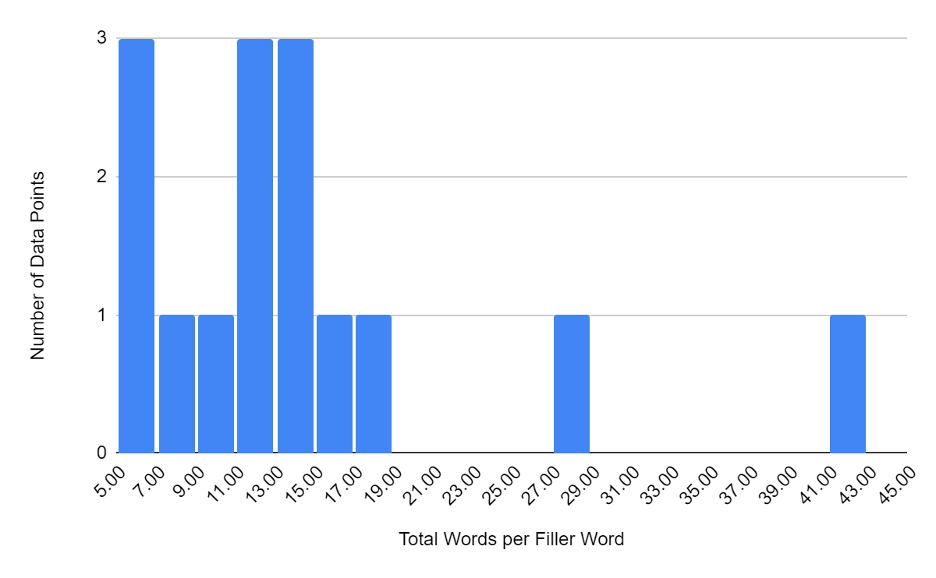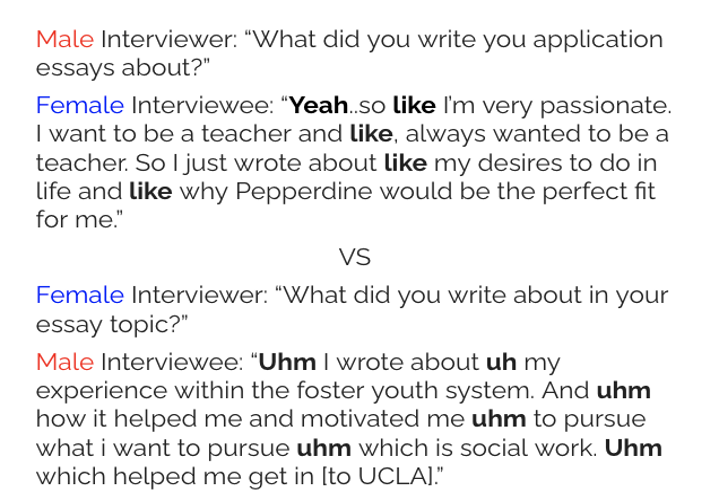Jennifer Beck, Jaymie Bernardo, Theo Chen, Karl Danielsen, and Calista Eaton-Steinberg
At some point in your life, you have probably experienced the intense awkward silence that comes about when it’s your turn to speak and you have no idea how to respond. Whether you’re not sure how to answer a question or you simply got lost in your train of thought, perhaps you’ve found yourself choosing one of these coping mechanisms to deal with that moment of dreaded stillness in the conversation: (1) you accept the silence and ponder your next move; (2) you fill the silence with filler words to buy time. Filler words such as “like,” “well,” and “um” are a common occurrence for people in conversation who are thinking of what to say. If you pay attention, you might notice that you use these words unconsciously in daily conversation, not even noticing when they slip out.
By observing, collecting, and analyzing video interviews, our study focuses on the correlation between gender and filler words in Californian college students. Studying the use of filler words in different genders of the cis-binary will allow researchers to better understand the way that gender and filler word usage interact. The purpose of this study is to clarify the assumption that women use more filler words than men due to persisting social pressures and the social implications of filler words.
Introduction and Background
Professor Eckert discusses in her linguistic studies that women typically have a different linguistic role in society compared to men (Eckert, 2012, pp. 90). When men speak, they try to keep up a persona that exudes confidence. As filler words explicitly foreground someone’s lack of confidence in speaking – they indicate that the speaker does not feel entirely certain about the things they are saying – men are presumed to more commonly avoid using filler words. In comparison, women generally assume a more mediating role in conversation (Van Herk, 2017, pp.110), so they might be expected to use more filler words.
Finding a connection between gender and filler word usage could indicate that one gender is less affected by the negative traits associated with filler words. In other words, one gender group may feel less social pressure to avoid filler words despite their pre-existing negative implications. Alternatively, one gender might actually prefer using filler words as modes of marking discourse to connect and organize the things they say in specific ways (Divett, 2014, pp. 37-42). A paper in the Journal of Language and Social Psychology found that men and women both use filler words equally when filling pauses, but that women use them more as discourse markers (Laserna et al., 2014, pp. 332-334). In this way, women use filler words to assert their authority in a conversation by directing its path and indicating it is their turn to speak. Due to the unprofessional associations with filler words, we hypothesize that women will use filler words more than men, as women face lower levels of societal pressure to sound professional. They may also utilize these words more often to direct conversation. We conducted a small-scale study of casual interactions between college-age men and women to assess the patterns of filler word use.
Methods
We analyzed 15 interviews of Californian college students posted on college-related YouTube channels. These casual one-on-one interviews asked random students basic questions about their college experiences. We looked at results from women interviewing men and men interviewing women and calculated the number of filler words (including “um/uh,” “like,” “yeah,” “so,” “I mean,” and “you know”) relative to the number of total words spoken.
Results/analysis
Previous research into this topic suggests that women do, in fact, use more filler words than men (Laserna et al., 2014, pp. 332-334). However, as gender roles become less important to our modern society, the previously discovered results may have become outdated. We set out to see if we could reproduce other studies’ outcomes in a modern, progressive college setting, while simultaneously seeking out answers as to what factors could cause the gendered differences in filler word usage.
While our final results matched those of previous studies in confirming a gender difference, the difference we found was not what we expected. Below are a couple of statistics from our data collection:

Looking at the overall ratio result, our results did not support the previous findings on this topic. Women surveyed actually used significantly fewer filler words than men. Looking at the overall total words to filler words ratio, males displayed a 9.651 ratio, while females displayed a 11.885 ratio, showcasing a 2.233 difference in filler word usage between the two genders. Oddly enough, the median of the data contrasted this. The median female used more fillers than the median male. This could potentially mean that men tend more towards extremes, while women speak more similarly across the board. Indeed, one interview with a male revealed the most filler word usage of all interviews, as the male spoke with almost one filler word per five words.
In spite of the inconclusive results of our mean/median analysis, two segments of the data did show a clear trend. Across all interviews, women and men showed preferences as groups for different filler words. Women favored the word “like,” which is increasingly androgynous but still closely associated with the “valley girl” archetype. Men, in place of using the effeminate “like,” preferred words such as “yeah.” It appears that both genders selected their filler words carefully to index different personas, even if they used filler words at similar rates. This means that social pressure is still strongly at play in word choice, even if neither gender has a stronger need for the confidence lent by decreased filler usage.
Both genders together indicated another interesting trend: the presence of two, not one, spikes on the graph of filler ratios. Figure 1 below shows that there is a peak of people using ~6 words/filler word and one of people using ~13 words/filler word. This two-peak system indicates that there are likely two separate modes of speech people use, one casual with a higher ratio of fillers, and one formal with a lower ratio. Filler word use overall is likely distributed across two standard deviations centered at these spikes.

Discussion/Conclusion
Our research shows that the differences in filler word usage across genders are more complex than previous findings suggest. Figure 2 below shows the transcript between two different interviews we observed, both being asked similar questions. You can see the female interviewee produces five filler words out of 43 words total. On the other hand, the male interviewee produces six filler words out of a total 40 words. The margin of filler word usage is slim here. As we mentioned before, females have been found to favor the filler word, “like” while men favored “yeah”. You will note that in this case, the male favored the word, “Uhm.” While not every male favors the same word, overall data suggests that there is still a generally consistent difference between male and female filler word choice, especially in the use of “like.”
This could be a result of gender stereotypes for speech – “like” and “so” are associated more with femininity, while “um” and “yeah” seem more masculine. There aren’t rules for who can say what, but speech can be very gendered. Part of it might be conscious – for example, males might avoid “like” for fear of sounding feminine – but it might also be a result of who these people are spending time around and what kind of speech they naturally pick up from friends and family.

It is important to keep in mind that the data used for our results was extracted from online videos of causal speech. Casual speech with a fellow young person allows for a more comfortable setting, therefore allowing for more filler words to be used. Because these videos were spontaneous and filmed, it is also possible that certain participants were more nervous than others, causing them to use more filler words as they collected their thoughts. Some people are more anxious speaking spontaneously in front of a camera, which would definitely affect their mannerisms, while other people might love being filmed and thrive in the same situation, speaking with confidence and ease.
Our current research sought to analyze the long-lived stereotype of women using more filler words than men, which may exist due to the even older stereotype of women having less intelligence. With these results, we come to the conclusion that college-aged males within California use filler words more frequently in casual speech than college-aged women in California. This could result from a number of factors. For one, more male college students are in STEM fields (Blackwood, 2020) where interpersonal skills are de-emphasized, and students might use more fillers. Men could also be more willing to index a casual persona in interviews because there are fewer expectations against their intelligence that they want to combat. With the persisting sociological stereotypes that deem women less intelligent, women have to work twice as hard in order to gain the respect that men have, especially within the work field (Eckert, 2012, pp. 90). Women are held to different expectations than men, which could impede on filler word usage.
Furthermore, a strong negative social stigma exists around young women who use filler words, especially “like.” Frequent use of the word “like” is a characteristic of the valley girl accent, a Californian accent associated with wealthy, unintelligent, and annoying young women. (This NPR article talks about some other ways that women’s language is stigmatized and disrespected). Since women have to overcome these pre-existing stereotypes, it is possible that they consciously work harder at not using filler words.
Should this research be conducted in another state with another age range, or in a more formal setting, the results may differ. However, our data challenges a conventional understanding of filler word use, suggesting that this topic is very complex and requires further investigation. Potential future research could look into formal interviews between an employer and potential employee, and whether this context decreases filler word use, regardless of gender. Research could also look into stereotypes surrounding different filler words, and whether these stereotypes consciously affect filler word use.
References
Crimson Education. (2013). Home [YouTube Channel], from https://www.youtube.com/c/CrimsonEducation/about
Divett, S., Duvall, E., Graham, T. Robbins, A. (2014) How and why people use filler words (pp. 35-46). https://schwa.byu.edu /files/2014/12/F2014-Robbins.pdf
Eckert, P. (2012). Three waves of variation study: The emergence of meaning in the study of sociolinguistic variation. Annual Review of Anthropology, 41, 87-100.
Laserna, C., Pennebaker, J., Seih, Y. (2014). Um . . . Who Like Says You Know: Filler Word Use as a Function of Age, Gender, and Personality. Journal of Language and Social Psychology. 33(3), 328-335. DOI: 10.1177/0261927X1452699 OR https://www.researchgate .net/publication /27 5005568_Um_Who_Like_Says_You_Know_Filler_Word_Use_as_a_Function_of_Age_Gender_and_Personality
ProWrite Admissions. (2017). Home [YouTube Channel]. YouTube. Retrieved November 16, 2020, from https://www.youtube.com/channel/UCpjORe_vOMevyxImw90igLw
Van Herk, G. (2017) Gender. What is Sociolinguistics? Wiley Blackwell. (pp. 97-115)
W.K.C., Kate Blackwood. (2020, July 1.). Gender gaps in STEM college majors emerge in high school. Cornell Chronicle. https://news.cornell.edu/stories/2020/07/gender-gaps-stem-college-majors-emerge-high-school